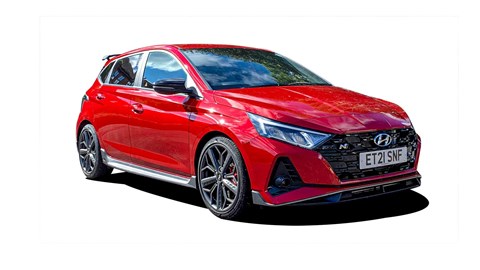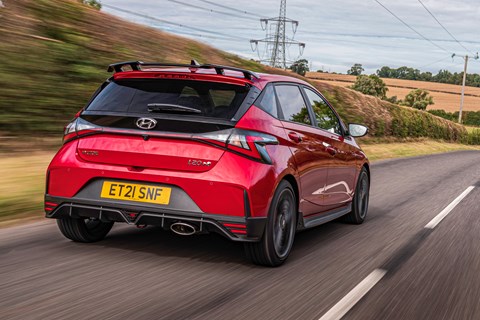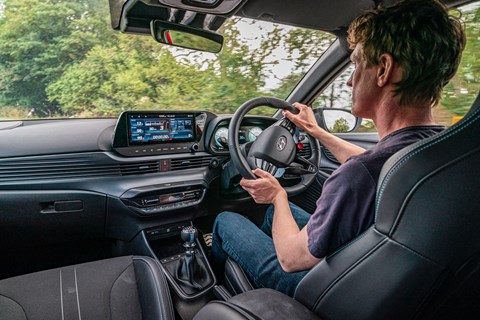► CAR lives with the i20N pocket rocket
► It’s been fun on B-roads and on track
► But what about living with one every day?
Month 2 of our Hyundai i20N long-term test: reality check
After last month’s burst of euphoria, time to give some doubts and qualifications an airing.
The i20N is relatively light, at 1190kg, but it doesn’t feel it because there’s so much heft in the steering. I’d rather have overly heavy steering than overly light but here it feels like unnecessary weight for the sake of a ‘sporty’ feeling, without bringing any extra feel or feedback. It actually makes the i20N feel less eager than it really is.
The best hot hatches on sale today
A BMW M engineer once told me they’re obliged to make the M5’s steering heavy because some drivers brace their body with their arms on the wheel when driving quickly, rather than with their left leg against the footrest, and need some force to push against to feel secure. Perhaps those findings made their way across to N division, too.
It’s a powerful front-wheel-drive car, so there’s a bit of torque steer, although there’s very little kickback through the steering, and the i20N is remarkably stable in the dry. It is firm, though, making rough roads hard work, if no more so than in the rival Ford Fiesta ST.
Although toggling through the drive modes doesn’t alter the Hyundai’s fixed-rate dampers, oddly it feels firmer in the sportiest modes. That placebo effect’s possibly because the stiffer resistance in the power steering’s heaviest setting transmits more of the road surface’s jolts through your forearms.
And then there’s the engine. It’s an all-new unit, with plenty going for it on paper including a new high-pressure injection system, but it’s not that thrilling on the road. A heavy flywheel gives throttle response a slightly lethargic feel, even though maximum torque is available from very low revs.

It emphasises turbo lag when you’re dipping in and out of the power through urban roundabouts in third gear, and on more open roads it’s not as keen to rev as traditional hot hatches, starting to feel strained towards the redline. You’re more likely to short-shift out of sympathy than make a lunge for the shift-light finishing line.
After borrowing the car, Ben Miller declared the brakes and gearbox to be fantastic, but suspected it was over-tyred, and reckoned it was more fun in the wet, up on its toes, ready to break into dance.
If this all sounds a bit harsh, it’s only because the i20N is otherwise such a talented car that minor flaws you wouldn’t think twice about in a lesser car stand out all the more starkly. Make no mistake, this is a great hot hatch.
By James Taylor
Logbook: Hyundai i20N
Price £24,995 (£25,545 as tested)
Performance 1598cc turbocharged four-cylinder, 201bhp, 6.2sec 0-62mph, 142mph
Efficiency 40.4mpg (official), 30.2mpg (tested),
158g/km CO2
Energy cost 21.5p per mile
Miles this month 432
Total miles 1414
Month 1 living with a Hyundai i20N: the start of our long-term test

Welcome aboard our new Hyundai i20N. With a weighty-feeling, fat-rimmed steering wheel in my hands (complete with quick-flick drive-mode shortcut buttons), firm suspension rat-a-tatting through the smart-looking, plump-bolstered sports seat and a raspy exhaust note in my ears, it’s definitely an N car.
Rewind to 2017 and not many people really know what an N car is, or how it feels. Hyundai’s N sub-brand is in its infancy and cynicism is rife. A performance sub-brand from Hyundai? A bit like M division? Eh?
Today, N’s part of the furniture. Thanks to a combination of solid marketing and a more than solid first car – the i30N – it’s hard to remember a time when its baby-blue signature colours and Brian Blessed exhaust volumes weren’t a part of the hot-hatch landscape.
The i30N hasn’t been the only N model – there’s the Veloster overseas and a new Kona N crossover has just landed – but it’s the i30 that’s done the majority of the heavy lifting for N’s credibility, and set the template for how an N car feels. With its big personality and brawny feel, it’s become a modern classic. Now here’s its most intriguing, most exciting follow-up. The i20N is a chance to see if the same attributes that make the i30N such a crowd-pleaser can be applied just as well to a smaller, cheaper, hot supermini.
On first listen, seems Hyundai’s aced the difficult second album: the i20N’s already charmed in the CAR magazine’s May 2021 300-mile test, and up against great small hot hatches old and new in Ben Oliver’s test in the August issue. While the GR Yaris won the day, the cheaper i20N more or less level-pegged with the benchmark Fiesta ST and put up a good fight against iconic modern classics like the RS Clio and Peugeot 205 GTI. What’s more, in the November 2021 issue during our Sports Car Giant Test, the plucky i20N weighed in £15k cheaper than its nearest competitor (and £515k less than the Ferrari SF90) and by no means disgraced itself.

Now a chance to understand how the i20N fares as a long player; as a package to live with every day.
Like anyone counting down the days to a new toy arriving, I’ve been immersing myself in the i20N’s details.
It has an all-new turbocharged 1.6-litre four-cylinder engine with 350-bar direct-injection pressure and a special ignition system. Rear suspension is by torsion beam, and with N-specific measures to make it even stiffer, the better for changing direction eagerly. Kerbweight is a scant 1190kg.
The N team got involved earlier in the development of the new i20 family than they did the i30, so they could set their requirements from the get-go and didn’t have to design a new front axle, for instance. Track-friendly stability control modes – Normal, Sport and Off – are similar to those of the i30N, and use the same software. All UK cars get a mechanical limited-slip diff as standard.
Unlike the i30N, it has passive rather than adaptive dampers in the interests of keeping the price below the £25k mark. To that end, there are few options available for the i20N in the UK: a Bose stereo upgrade, black roof and posher paint colours. Our car is in pearlescent Dragon Red (which costs an extra £550; so does the signature N Performance Blue but it’s nice to be different) and is otherwise option-free.

That interior’s luxurious, with no shortage of big-car toys in a supermini space: heated seats and steering wheel, a modern-looking and relatively user-friendly touchscreen and digi-dials combo and ambient lighting.
The cabin lighting system, which pools light in the door bins and centre console tray, reminds me a bit of being in an Odeon cinema, but at least it’s atmospheric. It’s a plusher environment than many bigger, pricier cars I’ve driven, and it’s impressively solid-feeling given the i20N’s light overall kilogram-count, too.
The i20N only just arrived, so flying time has so far been restricted to just a few short forays. On first spin, it’s great: big dry-weather grip and impressive stability, with faithful and consistent front-end feedback. Above all, the car’s alive with an infectious sense of enthusiasm that’s difficult not to like.
I do also have a few dynamic misgivings, though. But I’ll save them for the next report. After all, it’s good to keep some stuff back for the second album.
By James Taylor
Logbook: Hyundai i20N
Price £24,995 (£25,545 as tested)
Performance 1598cc turbocharged four-cylinder, 201bhp, 6.2sec 0-62mph, 142mph
Efficiency 40.4mpg (official), n/a mpg (tested), 158g/km CO2
Energy cost n/a
Miles this month 46
Total miles 982